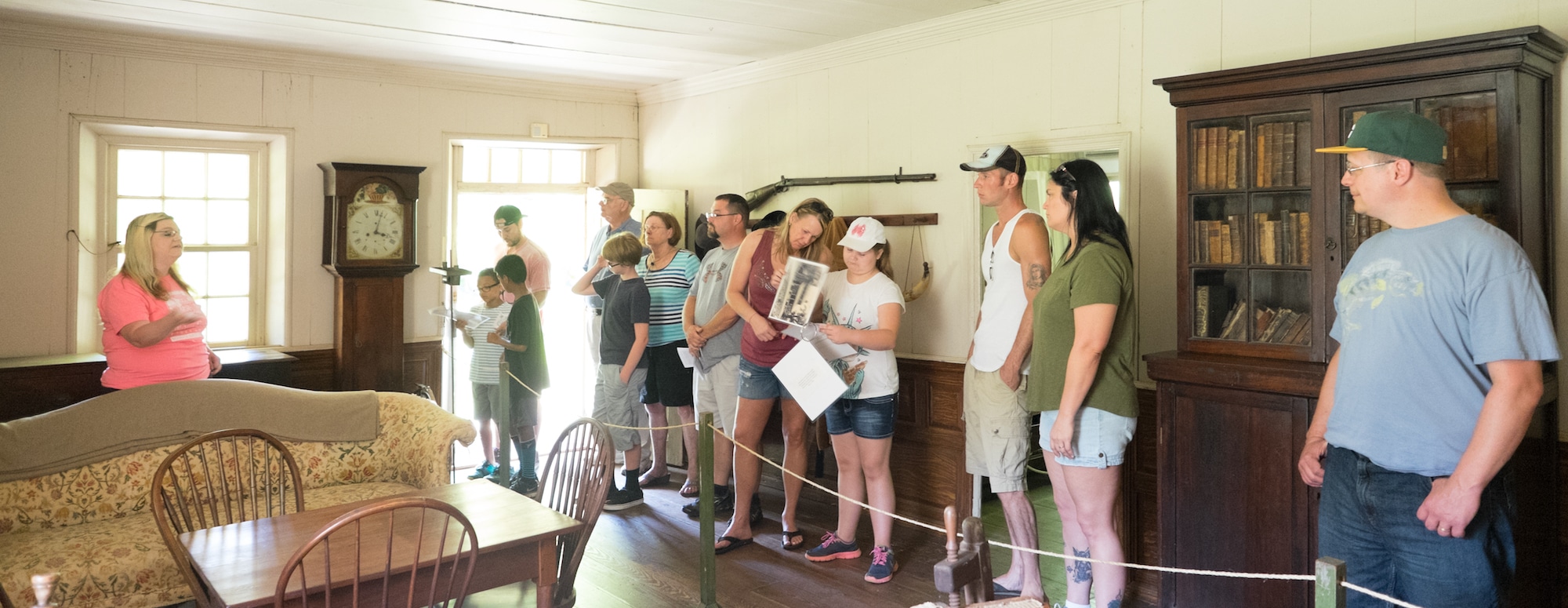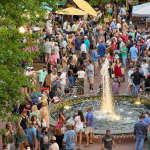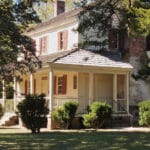A Visit to Walnut Grove
By Brad Steinecke, produced in cooperation with the HubCity Writers Project.
 Whenever I visit Walnut Grove Plantation, I like to take a few minutes to walk out into the field facing the house and close my eyes. I enjoy letting the 21st century fade away, focusing on the quiet breeze and imagining the familiar natural landscape of the post-industrial Upstate transformed into its former self—the hardscrabble frontier of the remote and unforgiving back-country. Revived in my mind are the bands of Cherokee braves, the wolves, the buffalo, and the vast, unspoiled forests and rivers of the Carolina Piedmont for hundreds of miles.
Whenever I visit Walnut Grove Plantation, I like to take a few minutes to walk out into the field facing the house and close my eyes. I enjoy letting the 21st century fade away, focusing on the quiet breeze and imagining the familiar natural landscape of the post-industrial Upstate transformed into its former self—the hardscrabble frontier of the remote and unforgiving back-country. Revived in my mind are the bands of Cherokee braves, the wolves, the buffalo, and the vast, unspoiled forests and rivers of the Carolina Piedmont for hundreds of miles.
The guides at Walnut Grove are skilled at sketching out that setting, but the grounds themselves, located just off Interstate 26 at U.S. 221, do a fine job of it on their own.
 Descendants of the Moore family, who built the house in the midst of that surrendered wilderness around 1765, donated enough land to hide the modern world from view, so with a little imagination, it’s not too difficult to envision that old farmhouse in the mid-18th century. I can still see the farm fields and nearby woodlands, but only in my mind’s eye can I sense the solitude of that little settlement, the daunting task of carving out a living from soil and labor, and the very real dangers of starvation or attack by Indians.
Descendants of the Moore family, who built the house in the midst of that surrendered wilderness around 1765, donated enough land to hide the modern world from view, so with a little imagination, it’s not too difficult to envision that old farmhouse in the mid-18th century. I can still see the farm fields and nearby woodlands, but only in my mind’s eye can I sense the solitude of that little settlement, the daunting task of carving out a living from soil and labor, and the very real dangers of starvation or attack by Indians.
Walnut Grove is an exceptional place. It was one of the very first houses built by settlers in what is now Spartanburg County. The Moores would have said they were in the Tyger River Settlement, a collection of a few Presbyterian Scots-Irish families who had trekked from Pennsylvania down along the Appalachian Piedmont to the Tyger River, where they claimed royal land grants, cleared the woods, and built a church. Many of those families are still here, witnesses to two and a half centuries of Southern history.
 Nowadays the house is maintained by the Spartanburg County Historical Association, which opens the house and grounds for tours throughout the year. If you only visit once, the best time to go is the first weekend of October, when artisans and Revolutionary War re-enactors descend on the plantation to recreate a skirmish that took place at the house near the end of the war, when partisan conflict reached its bloodiest in the Carolina back-country. More interesting to me are the craftsmen who demonstrate 18th century trades. I once spent a few sooty hours in the blacksmith’s forge as a kind of tribute to the Revolutionary-era blacksmith in my own family. I found the process of working iron fascinating, but even more entertaining were the stories handed down by generations of craftsmen.
Nowadays the house is maintained by the Spartanburg County Historical Association, which opens the house and grounds for tours throughout the year. If you only visit once, the best time to go is the first weekend of October, when artisans and Revolutionary War re-enactors descend on the plantation to recreate a skirmish that took place at the house near the end of the war, when partisan conflict reached its bloodiest in the Carolina back-country. More interesting to me are the craftsmen who demonstrate 18th century trades. I once spent a few sooty hours in the blacksmith’s forge as a kind of tribute to the Revolutionary-era blacksmith in my own family. I found the process of working iron fascinating, but even more entertaining were the stories handed down by generations of craftsmen.
The manor house, although quite simple compared to Lowcountry plantations, is furnished with unusual precision. A full inventory of house goods survives from early 1800s and authentic period pieces recreate the Moore household, from trundle beds to fire boards, the result of a years-long restoration effort in the early 1960s. Pre-restoration photos show the remarkable work that brought the house back to its original splendor from its ramshackle, neglected state after decades of tenant farming.
In addition to the house and forge, there are gardens, a barn, a schoolhouse, and a doctor’s office, all in place to interpret facets of the Moore family and illustrate their place in the greater community. The Moores were wealthier than most of the early generation of settlers in Spartanburg County, but the house doesn’t seem especially grand today. I was surprised by the thin interior walls and cramped stairwell, but compared to the windowless one-room cabins lived in by most of their contemporaries, even the smallest luxuries were exceptional.
Running to the rear of the house is a woodland trail along a slope. Too steep to farm, the woods there are likely a tiny remnant of the old growth forests that once blanketed the entire region. That hasn’t stopped the usual invasive plants from claiming a space among the hickories and oaks, but the overall terrain harkens back to that primeval forest the Moores would have known. I like seeing the fallen timber grown over with moss and shelf fungus, returning the borrowed nutrients and freeing up canopy space for the next generation of noble trees.
The trail ends at the old family cemetery, where dozens of finely-carved stones stand beside a far larger expanse of unmarked slave graves. Still envisioning the days of a frontier Piedmont, I imagine grieving Africans at the side of a shrouded loved one, tribal mourning customs perhaps tempered somewhat by Presbyterian austerity. It’s said that the first of the unmarked graves here belong to two Patriot militiamen killed by “Bloody Bill” Cunningham during the skirmish reenacted every fall at the house.
Following an old roadbed back to the house, it becomes apparent why the Moores chose this spot for their new life in the Carolina hinterlands. The road follows a slight ridge that levels out to a plateau where the house is situated. Standing on the porch, the house faces out to fields that gradually slope down to the Tyger River. Before development chipped away at those ancestral lands and the rest of our collective landscape, the view of those hundreds of acres would have been magnificent. Still, as a place apart, Walnut Grove retains something of its frontier spirit. We need these places to ground us, and Spartanburg is fortunate to have it.
Brad Steinecke, Produced in cooperation with the HubCity Writers Project.
 Brad Steinecke is a Spartanburg native who works as an archivist and historian for the Spartanburg County Public Libraries. He, his wife and son live in Hampton Heights.
Brad Steinecke is a Spartanburg native who works as an archivist and historian for the Spartanburg County Public Libraries. He, his wife and son live in Hampton Heights.





